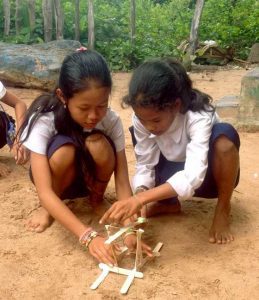Over the past few months, PLF Intern Hannah has been working to develop a science curriculum at Knar School. Here is her update on how much she and Teacher Ka’Oun have accomplished so far! “My first big project this year picked up on the great successes of the Knar School science club pilot project. I was given a set of twelve physical science lesson plans in English, and Teacher Ka’Oun and I teamed up to implement the curriculum for an eager class of 23 students in Grade 6. Each Sunday, Ka’Oun and I sat down to go over the lessons for that week: I would teach to him in English, he would explain the lesson back to me, and we would talk through the gaps together to make sure he could confidently teach each lesson in Khmer on his own.
On days when we held experiments, I would pack a basket of supplies from the PLF volunteer closet and join the class to watch Ka’Oun teach and help lead anything from an egg drop challenge to building rocket balloons. Each week was a new adventure; laughter when Srey Poh’s tongue depressor bridge fell apart at the last minute, curious eyes and helping hands when, inevitably, some of the experiments fell short, and delighted shrieks when our plastic cup telephone successfully carried a conversation from our classroom all the way to the end of the school building.
Each day after class the excitement trailed along the road to school as the students proudly carried their creations back home to share with their family.
Ka’Oun’s favorite topic was gravity, a section which the kids enjoyed with equal enthusiasm. This was also my first challenge with the lessons, for after teaching through the presentation once, I quickly realized that Ka’Oun been taught that gravity came from a sort of magnet in the center of the Earth. It took some reworking, a supplementary video, and trust that gravity exists even if we don’t exactly know why.
The adventure continued when we collected various objects to drop from the top of a ladder at school. How could it be possible that a soccer ball and a pom-pom could fall at the same time?! The kids must have spent at least 20 minutes making absolutely sure it could be true: belly-down on the ground for the best vantage point, each student peering in closely as Tep counted to three from the top of the ladder.
The full curriculum covered twelve different lessons: gravity, light and optics, sound waves, and simple machines to name a few. We experimented with catapults, rainbows, bridges, and endless amounts of balloons. We supplemented with videos about brushing your teeth in space and impromptu lessons about thunder and lightning at the eager request of the students. Our initial lesson plans have retained the same shape, but implementing each lesson and translating it literally and figuratively into the Cambodian mindset drove me to learn the most.
The students were way ahead of me when it came to discussing alternate forms of energy (solar lights and water power are abundant in rural areas), but no one has ever experienced static electricity in Cambodia’s humid climate. Some of the materials needed for experiments required town-wide scavenger hunts or even transportation all the way from the US, and distilling refraction into a lesson that can be easily explained and translated requires attention to the nuanced style of Cambodian education – a process I’m still working on mastering.
We now stand with a tried and true physical science curriculum in both English and Khmer, a solid framework for Ka’Oun to teach independently in the future, and an enthusiastic gang of grade 6 scientists who can’t wait to learn more. “Hannah can you teach us about the planets next? How do cell phones work? When will we see you again?”


Recent Comments